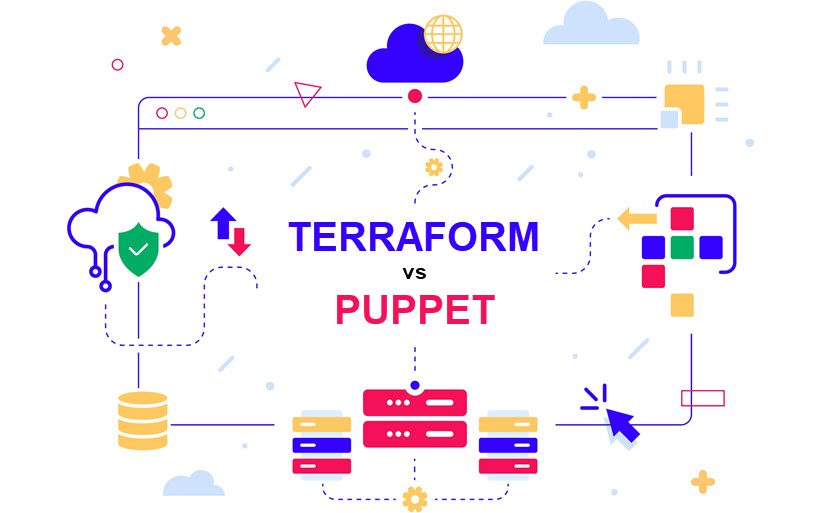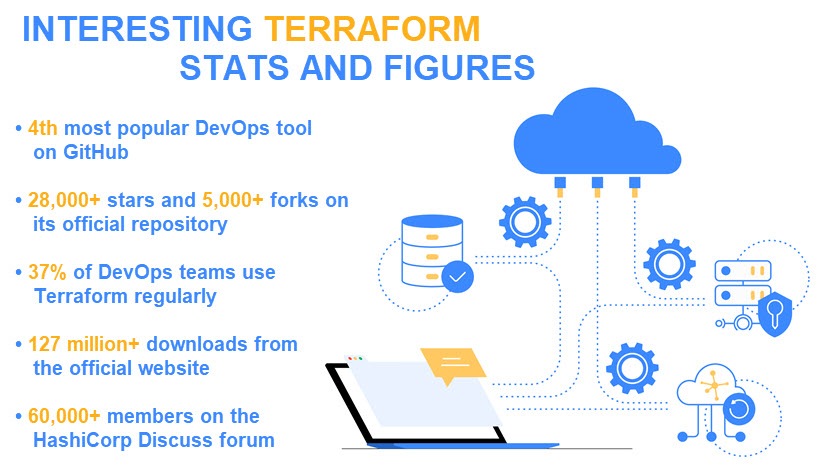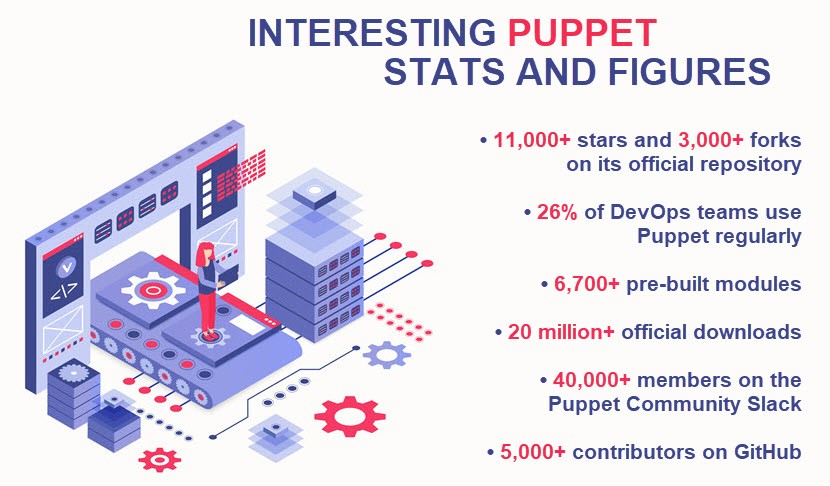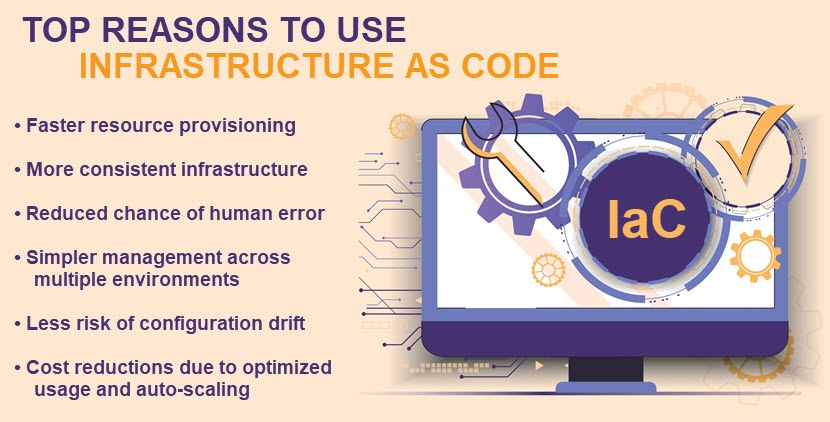Terraform vs Puppet: What Are the Differences?
Terraform and Puppet are two popular Infrastructure as Code (IaC) tools that enable users to streamline infrastructure management and deployment. Both tools have similar features and a loyal following, but the two excel at different use cases and it's often difficult to tell when one is a better choice than the other.
This article provides an in-depth Terraform vs Puppet comparison that goes through all the must-know differences between the two tools. We also outline the main pros and cons of both platforms, so you'll find all the info you need to make an informed decision on which solution is the better fit for your IT needs.

We suggest you learn about the basics of Infrastructure as Code before you start reading about specific IaC tools and how they compare to each other.
What Is Terraform?
Terraform is an open-source IaC tool that enables users to create, manage, and version infrastructure resources (both on-prem and in the cloud). This tool works on a variety of operating systems (Windows, MacOS, Linux, FreeBSD, OpenBSD, Solaris, etc.) and supports all major cloud providers.
Terraform uses HashiCorp Configuration Language (HCL), a declarative language similar to JSON. You use HCL to specify what you want your infrastructure to look like and Terraform automatically reaches the desired state on the node.
Terraform supports a wide range of resource types (virtual machines, databases, load balancers, etc.) and excels at use cases with cloud-based infrastructure.
Main pros of Terraform:
- A human-readable declarative language.
- High levels of automation throughout the infrastructure lifecycle.
- An emphasis on infrastructure consistency.
- A cloud-agnostic tool ideal for multi-cloud deployments.
- Does not require any software on the managed infrastructure.
- Easy reuse of code and module sharing.
- Users can trigger Terraform from within most CI/CD pipelines (GitLab, Jenkins, Circle, etc.).
- Has the backing of a large and active community.
Main cons of Terraform:
- Becomes complex to manage when dealing with large and complex infrastructure.
- Users must carefully manage the Terraform State file (.tfstate) to avoid merge conflicts and unwanted changes.
- The enterprise version of the tool is expensive, and the open-source edition does not include support services.
- No built-in GUI for any version of the tool.
Learn how to provision infrastructure with Terraform and see how much this IaC tool speeds up and streamlines deployments.

Terraform Features
Here's an overview of Terraform's most notable features:
- A simple and concise configuration language for describing the desired state of resources.
- Allows users to version, review, and test infrastructure as any other codebase.
- Complete resource lifecycle management (including creating, updating, and deleting resources).
- Efficient state management that allows users to track current states.
- Variables within templates that boost resource reusability.
- A variety of modules that speed up deployments and help package, share, and reuse configuration files.
- Drift detection that identifies any changes made outside of Terraform (e.g., a manual change made in the cloud console) and syncs them with the desired state.
- Applies changes to multiple resources in parallel to speed up infrastructure deployments.
- Dependency graphs that help determine the correct order in which to create and update resources.
- Resource graphs that provide a visual representation of the infrastructure.
- A plan and apply workflow that enables previews before changes, a feature that significantly lowers the risk of accidental or unexpected updates.
- Enables users to create and install custom plugins to extend the tool's functionality.
Terraform fully integrates with Bare Metal Cloud (BMC), our cloud-native dedicated server platform. This integration enables users to deploy new BMC servers in minutes and with only a few lines of code.
What Is Puppet?
Puppet is an open-source IaC tool that allows users to manage and automate the deployment and configuration of infrastructure. The tool works on Linux, Windows, and Unix-like operating systems.
Like Terraform, Puppet uses human-readable declarative statements. Users describe the desired state of infrastructure in Puppet DSL (Domain-Specific Language) and the tool automatically matches that state.
Puppet uses a client-server architecture, so users must set up a master server that manages the configuration of other nodes. The tool comes in two versions: open-source and enterprise. Enterprise Puppet provides various advanced features helpful for DevOps teams, including:
- Real-time reporting.
- Role-based access control.
- Node management.
Puppet is a popular IaC solution in enterprise environments and is a go-to option for managing large-scale deployments across multiple on-site data centers and cloud providers.
Main pros of Puppet:
- Even the free version of the tool is feature-rich and highly customizable.
- Uses agents to keep server states as consistent as possible.
- The client-server management helps control configuration drift.
- More than 6,700 custom and official modules.
- Easy and robust module testing.
- Has the backing of a massive and active community of users.
Main cons of Puppet:
- Relatively complex to manage on a day-to-day basis (especially compared to Terraform).
- A steep learning curve for less experienced developers.
- The tool is resource-intensive when running a large number of nodes.
Want to give Puppet a go? Check out our guides to installing Puppet on Ubuntu and MacOS.

Puppet Features
Here's a quick overview of Puppet's most notable features:
- A human-readable DSL for writing declarative code.
- Automation for different software lifecycle stages (provisioning, patching, configuration, management, etc.).
- Infrastructure configurations are idempotent, which means you can run the same set of configurations multiple times on the same machine without changing the system state.
- Built-in support for version control.
- Relies on a server-client architecture in which a master node collects details of the target machine, compares the retrieved data with defined configurations, and gets the system into a desired state.
- Helpful visual workflows.
- A catalog of per-node resources that helps optimize performance.
- An override mechanism that enables users to override a specific instruction.
- Real-time, context-aware reporting that allows you to monitor the status of nodes, track changes, and troubleshoot issues.
- An optional database (PuppetDB) for storing and querying information about nodes, facts, and resources.
Check out our articles on the best DevOps and CI/CD tools to see what other platforms are worth adding to your tool stack.
Short Background on Terraform and Puppet
HashiCorp launched Terraform in July 2014. The tool was open-source from the start, but it only supported AWS at the time. By 2016, Terraform provided full support for Microsoft Azure, Google Cloud, and OpenStack.
In 2017, Terraform saw a significant increase in downloads as the tool's popularity skyrocketed. As a result, Microsoft partnered with HashiCorp and publicly acknowledged Terraform as a go-to IaC tool for Azure.
HashiCorp's focus between 2018 and 2022 was on commercializing the tool, an effort that resulted in the launch of Terraform Enterprise. Since then, the tool saw even more growth, as evidenced by the following figures:
- Terraform has over 127 million downloads from its official website.
- Over 10% of the Global 2000 companies and more than 15% of the Fortune 500 organizations use Terraform Enterprise.
On the other hand, Puppet became available in 2005 and is one of the oldest declarative tools still on the market. Puppet's founder (Luke Kanies) developed the tool to help him manage a large number of servers without having to manually tweak each device.
Puppet initially gained popularity mainly within the Linux community, but the tool gradually extended to other operating systems. In 2011, Luke founded Puppet Labs (now known as Puppet, Inc.) to provide commercial support and services for the tool.
Over time, Puppet grew into a full-blown IaC offering with excellent features. The commercial version of the tool (Puppet Enterprise) offers one of the market's most well-rounded IaC solutions.
Terraform vs Puppet: Comparison
The table below offers a detailed Terraform vs Puppet comparison:
| Point of comparison | Terraform | Puppet |
|---|---|---|
| Developed and maintained by | HashiCorp | Puppet, Inc. |
| Initial release date | 2014 | 2005 |
| Open-source | Yes | Yes |
| Primary focus | Infrastructure provisioning | Configuration management |
| Configuration language | HCL (HashiCorp Configuration Language) | Puppet DSL (Domain-Specific Language) |
| Notable integrations | AWS, Azure, Google Cloud Platform, Docker, Kubernetes, etc. | AWS, Azure, Google Cloud Platform, Docker, Kubernetes, VMware, Cisco, etc. |
| Setup complexity | Moderate | Complex |
| Cloud-agnostic | Yes | Yes |
| Idempotent configurations | Yes | Yes |
| Modules | Yes (from the Terraform Registry) | Yes (from Puppet Forge) |
| Multi-cloud support | Yes | Limited |
| Client-server architecture | No | Yes |
| Agent installation | No | Yes |
| State management | Yes | Yes |
| Push vs. pull | Follows a push workflow | Follows a pull workflow |
| Resource types | A smaller set of resource types specific to infrastructure provisioning (virtual machines, load balancers, and databases) | A broad range of types (files, packages, services, users, etc.) |
| Reporting and auditing features | Limited | Excellent (for the Enterprise version of the tool) |
| Built-in availability features | Yes | No |
| Built-in scheduling | No | Yes |
| Out-of-the-box GUI | No (but there are third-party plugins) | No for the free version of the tool, yes for Puppet Enterprise |
| Community support | Large and active | Large and active |
| Detailed documentation | Yes | Yes |
| Learning curve | Moderate | Steep |
| Optimal use cases | Deploying and automating infrastructure across multiple cloud providers and services | Managing configuration across large-scale, complex environments that combine both on-prem and cloud resources |
| Pricing | The basic version is free, the enterprise edition charges prices based on usage | The basic version is free, the standard edition is ~$100 per node, and the premium version is $199 per node |
Let us now take a closer look at the most notable differences between Terraform and Puppet.
Management and Scheduling Capabilities
Puppet is first and foremost a configuration management tool with a focus on defining the desired states in code. The tool also provides several extra features that help better manage configurations, such as:
- Inventory management that tracks all nodes (their status, configuration, and history of changes).
- Real-time reporting on the current state of infrastructure.
- Built-in support for version control of configuration code.
Puppet provides some scheduling capabilities. For example, you can use the schedule resource type to define tasks the tool should execute at a certain time (e.g., run a backup or apply an update).
On the other hand, Terraform is primarily an infrastructure provisioning tool with a focus on automating resource creation (virtual machines, databases, networks, storage, etc.). The tool has several noteworthy management features, the most notable of which are:
- Management of the lifecycle of infrastructure resources (creation, updates, deletion, etc.).
- State management that tracks the current state of infrastructure and all applied changes.
Terraform does not have any built-in scheduling capabilities. You can use external tools or services to schedule Terraform runs (such as AWS Lambda).
Setup Difficulty
Puppet's setup process is more complex than installing Terraform, especially if you don't have hands-on experience with the tool. Setting up Puppet is a three-step process:
- Set up a Puppet master server, the central point of control for the infrastructure. The user must install the Puppet server software, configure SSL certificates, set up authentication and authorization rules, and configure the master server.
- Install an agent on every node you plan to manage. The user must add a repository to the node, install the agent package, and connect the agent to the master server.
- Write a Puppet manifest to define the desired state of infrastructure.
Setting up Terraform requires the following steps:
- Install the Terraform CLI (via a Terraform binary for the chosen platform) you'll use to define and manage resources.
- Define the infrastructure by describing the resources and any relevant dependencies.
- Run Terraform commands to create or modify infrastructure (terraform init, terraform plan, terraform apply, etc.).
Check out our article on Terraform installations to see the easiest ways to get the tool up and running on Windows, Linux, and MacOS.
Ease of Use
Puppet tends to have a steeper learning curve than Terraform. The two most common reasons some struggle with Puppet are:
- The Puppet DSL language is challenging for beginners.
- Defining and managing infrastructure resources requires more tasks than with Terraform.
Despite these difficulties, users with experience in IaC and configuration management will not have any significant problems with Puppet.
On the other hand, one of the main selling points of Terraform is its ease of use. The tool is an excellent choice for beginners new to IaC due to the user-friendly HCL and helpful error messages.
Available Modules
Puppet modules are templates of code that define a particular infrastructure resource. Modules are reusable and modular, so they enable users to quickly define the desired state of infrastructure.
Users download Puppet modules from a variety of sources, but the most popular one is Puppet Forge, an official repository of more than 6000 modules.
Once they download a module, users install them using the puppet module command and manage them using the Puppetfile (a manifest that defines the modules and their dependencies).
Terraform also features reusable and shareable modules that define a particular resource (or a set of resources). The most popular source of modules is the Terraform Registry, a repository that contains thousands of modules that speed up the Terraform experience.
Users install modules via the terraform init command and manage them using the terraform module command.
GUI
The open-source version of Puppet does not have a built-in GUI, so users must rely on command-line tools and text editors to manage configurations. Puppet Enterprise provides a web-based GUI for managing infrastructure and enables users to:
- View the status of Puppet runs.
- Manage modules.
- Edit Puppet code.
- Manage and classify nodes.
- View reports.
Terraform does not provide a built-in GUI, but you have the option to integrate the platform with third-party tools. All major providers have a web-based console for managing resources, plus there are several plug-ins to choose from (such as the popular Terraform VS Code).
Availability
Puppet does not have any built-in availability support. However, there are two common strategies users rely on to boost availability:
- Set up a client-server configuration in which multiple master nodes share the load and act as failovers for each other in case something goes wrong.
- Use an external database to store configuration data instead of solely relying on the Puppet master's built-in database.
On the other hand, Terraform has several features that help boost infrastructure availability, such as enabling users to:
- Deploy infrastructure resources to multiple cloud providers.
- Store states in a remote backend (e.g., Amazon S3 or HashiCorp Consul) to improve fault tolerance.
- Manage multiple configurations separately via Terraform workspaces.
- Integrate Terraform with CI/CD tools to automate the deployment of resources.
Learn about high availability (HA) and see why avoiding downtime is a priority for any type of infrastructure.

Terraform or Puppet: How to Choose?
It's often difficult to choose between Terraform and Puppet since both tools have excellent IaC capabilities, free versions, and active communities. However, understanding your tech needs (IT priorities, team's skill set and preference, compliance, infrastructure types, etc.) helps pick between the two solutions.
Terraform stands out as the better option when you are:
- Primarily looking for an infrastructure management tool.
- Looking for an agentless IaC tool.
- Running most (if not all) of your infrastructure in the cloud.
- Managing resources across multiple cloud providers (or across multiple regions within a single provider).
- Looking for native support for container orchestration platforms like Kubernetes.
On the other hand, Puppet is the better option when you are:
- Primarily on the market for a configuration management tool.
- Looking for an IaC tool that requires agent installations on nodes.
- Running an infrastructure that equally uses both on-prem and cloud resources.
- Managing configurations across a large number of servers (100+) with a diverse set of operating systems.
- Chiefly worried about configuration consistency (either due to compliance concerns or an increased security risk).
Remember that Terraform and Puppet are not mutually exclusive. Many teams opt to use both tools. A common strategy is to use Terraform to provision cloud resources and then rely on Puppet to configure those resources once they're up and running.
Interested in more comparison articles? Check out these posts:
- Pulumi vs Terraform: Comparing Key Differences
- Helm vs Terraform: What Are the Differences
- Terraform vs Kubernetes: What Are the Differences
- Kubernetes vs. Docker: Differences and Similarities Explained
- Docker Swarm vs Kubernetes: What are the Differences?
- Ansible vs Terraform: What Are the Differences?
Give Both IaC Tools a Go
While this article offers a detailed comparison of Terraform and Puppet, we also suggest giving both tools a try before deciding which one is a better fit for your organization. Test their open-source versions and see how both tools align with your use cases and team before committing to either the enterprise edition of Terraform or Puppet.